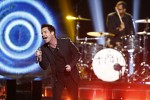At a pivotal point in her new song “Welcome to New York,” Taylor Swift sings, “And you can want who you want, boys and boys and girls and girls.”
You read that correctly. A key line in a specific love letter to the uniquely iconic New York City written by one of mainstream music’s most unique storytellers offers a generic, innocuous cliche about equality of love. It offers a generic, innocuous cliche that could have been written by anyone about any cosmopolitan environment.
That misalignment of conception and execution underscores the stunningly rare failure that is the opening track on Taylor Swift’s new album “1989.”
In hyping her new album, Swift has spoken lovingly about the role her new home of New York City has played in driving her evolution–and maturation–as a songwriter. According to Swift, “New York has been an important landscape and location for the story of my life in the last couple of years.”
If that is true, and “Welcome to New York” is supposed to represent the acknowledgment and celebration of that influence, then one can safely conclude that nothing has happened in Taylor Swift’s life in the last couple of years.
From start-to-finish, “Welcome to New York” speaks only in empty cliches about big city life. Concepts like bright lights, finding the best version of oneself and embracing unpredictability all exist in youthful fantasies about moving on up to cosmopolitan America, but they say nothing about the specific contrast between New York and any other major city. They say nothing about the uniquely empowering aura one–especially one as enamored as this particular singer-songwriter–experiences when actually living in New York City.
More disappointingly, they say nothing of the unique way Taylor Swift fits into the New York dynamic. Swift’s best songwriting is resonant not because it takes no sides or offers no specificity but because it so vividly portrays her honest feelings. Listeners might not share in Swift’s exact experiences, but thanks to her ability to convey detail and authentic emotion, they can feel connected to her story and to her music. Here, one gets no insight into Swift’s unique New York perspective or experience and thus has no way of illuminating his own perspective towards big city life–or his own life.
That “Welcome to New York” is designed not merely as an anthem for the Big Apple but also as a stage-setter for Swift’s new album renders the vapid, disconnected, impersonal songwriting particularly damaging. Save for demonstrating the new type of sound Swift will pursue on the balance of “1989,” “Welcome to New York” says nothing about the woman Swift is, the stories she will tell and the messages she will share on the subsequent tracks. We know that Swift is now living in a big, wondrous place, but we gain no sense of how that environment is impacting her — or how she is transitioning into that environment.
We thus have no gauge of the emotion and mindset at the core of “1989.”
Unfortunate about the song’s failure to capture the unique intricacies of New York, Taylor Swift and Taylor Swift’s experiences in New York is the fact that the record is, in some respects, a clear triumph.
Notably, it is a Ryan Tedder collaboration that does what virtually no such collaboration–even those involving unique powerhouses like Adele and Beyonce–has been able to do: establish a legitimately distinct musical identity.
While Tedder is an irrefutably prolific and dynamic writer-producer, he has certain proclivities that emerge, rather overtly, in the majority of his recordings. Everything from style of percussion, to the use of chanted background vocals, to the start-and-stop transitions, to the signature crescendos is decidedly Ryan Tedder, which makes it rather easy to identify one of his writing and/or production efforts. Valuable insofar as his signature style is commercially and aurally appealing, it becomes problematic when it homogenizes artists who are anything but cookie-cutter.
One should not, for instance, be able to picture Ryan Tedder and his band OneRepublic singing the same songs as Ella Henderson and Adele. Yet listen to “Ghost” and “Rumour Has It” and try claiming, with a straight face, that you could never envision Tedder singing those songs.
When it comes to Taylor Swift, the greatest fear about a transition into the realm of pure pop was that it would dampen her instantly identifiable lyrical voice and sense of melody. Announcing a collaboration with Ryan Tedder, a writer-producer who is known for overshadowing singers’ unique styles, is the last thing one would do to dismiss concerns about preservation of musical identity.
Yet in either a testament to Swift’s influence or to the approach Tedder and frequent collaborator Noel Zancanella took when working on this song, it does feel distinct from the bulk of his other work. One would not necessarily be shocked to learn that Tedder and Zancanella worked on this song, but one would surely not identify their influence on this one with the same ease he would when pegging their contribution to something like Maroon 5’s “Maps.”
Offering a clever juxtaposition of a dark, brooding rhythmic line one might expect from a BANKS or Lorde record with bright melodic support, the synth-driven record emerges as instantly memorable, admirably cutting-edge pop. While a bit too constraining to produce a legitimately soaring anthem–“Empire State of Mind” this is not–it effectively captures the whirlwind of emotion associated with the New York experience.
For her part, Swift delivers some truly compelling vocal moments. While overproduction and stiff navigation of notes hampers the early part of the song, Swift comes into her own at the bridge and closes with a raw, unhinged and utterly captivating vocal performance in the final chorus.
Musically, “Welcome to New York” is something special. It is not quite as catchy as it wants to be–the words and melody feel awkwardly shoehorned into the groove at times, and there is a repeated use of “forevermore” that will forever seem out of place–but it definitely provides the needed backdrop for a successful Swift effort.
But in a rare twist, the lyrics and personality–the two things that will forever take center stage in a Swift song–do not live up to the task. They are hollow, disconnected and not indicative of the artist Taylor Swift was, is and must continue to be.




